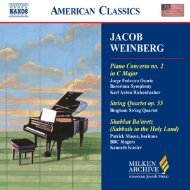Download Liner Notes PDF - Milken Archive of Jewish Music
Download Liner Notes PDF - Milken Archive of Jewish Music
Download Liner Notes PDF - Milken Archive of Jewish Music
You also want an ePaper? Increase the reach of your titles
YUMPU automatically turns print PDFs into web optimized ePapers that Google loves.
Theological Seminary, played by the Fountain<br />
Ensemble as part <strong>of</strong> the Seminary’s and the <strong>Milken</strong><br />
<strong>Archive</strong>’s jointly sponsored international conferencefestival,<br />
“Only in America.”<br />
Beginning in the late 1920s,<br />
for more than four decades,<br />
ABRAHAM WOLF BINDER<br />
(1895–1966) was one <strong>of</strong> the<br />
most prominent figures among<br />
the stimulating intellectual<br />
and artistic <strong>Jewish</strong> music circles<br />
in the New York area. He was<br />
also one <strong>of</strong> the few native<br />
Americans <strong>of</strong> that mostly<br />
émigré milieu <strong>of</strong> composers,<br />
musicologists, learned cantors,<br />
other synagogue musicians, and critics who—through<br />
their sometimes overlapping academic societies and<br />
journals—promoted a renaissance <strong>of</strong> interest in serious<br />
deliberations about Judaically related music. At the<br />
same time, from a practical perspective, they sought to<br />
raise the musical standards in American synagogues.<br />
Binder was reared in an orthodox environment<br />
(his father was a ba’al t’filla, or lay cantor), and he<br />
commenced his <strong>Jewish</strong> musical experiences as a boy<br />
chorister in an orthodox synagogue. At the age <strong>of</strong><br />
fourteen in the densely concentrated eastern European<br />
immigrant neighborhood <strong>of</strong> New York’s Lower East<br />
Side, he led a choir for the locally distinguished cantor<br />
Abraham Singer, and through various succeeding<br />
positions and associations and self-tutored studies, he<br />
acquired a thorough familiarity with the full range <strong>of</strong><br />
the eastern and west-central European cantorial and<br />
synagogue choral repertoire. It was within the American<br />
Reform movement, however, that he eventually used<br />
that knowledge and early experience to make his most<br />
important contributions and leave his most enduring<br />
mark—not only as a composer for the liturgy, but<br />
equally as a pedagogue, writer, lecturer, editor, choral<br />
director, and general savant. Perhaps more than any <strong>of</strong><br />
his contemporaries or colleagues, he can be credited<br />
with having lifted the American Reform musical scene<br />
out <strong>of</strong> its nationwide malaise by introducing substantial<br />
amounts <strong>of</strong> authentic tradition. As a prime mover in that<br />
restoration <strong>of</strong> liturgical music tradition, he enriched and<br />
infused Reform practice with long-established melodies,<br />
biblical cantillation, and the adapted work <strong>of</strong> some <strong>of</strong><br />
the principal European synagogue composers <strong>of</strong> the<br />
modern era. At the same time, he befriended many <strong>of</strong><br />
the synagogue composers who immigrated to America<br />
during the 1930s and 1940s, and he encouraged them to<br />
continue expanding the aggregate repertoire with their<br />
own compositions.<br />
Born in New York City, Binder attended the Settlement<br />
<strong>Music</strong> School there, and then Columbia University<br />
from 1917 to 1920, graduating from the New York<br />
College <strong>of</strong> <strong>Music</strong> with a bachelor <strong>of</strong> music degree.<br />
During that time, in addition to various choral<br />
conducting positions, he was appointed music director<br />
<strong>of</strong> the YMHA/YWHA (Young Men’s and Women’s<br />
Hebrew Association, now known as the 92nd Street Y,<br />
a <strong>Jewish</strong> counterpart to the YMCA network), where,<br />
in addition to teaching music, he organized a choral<br />
society and an orchestra. He also became an instructor<br />
<strong>of</strong> liturgical music in 1921 at the <strong>Jewish</strong> Institute <strong>of</strong><br />
Religion, which merged in 1950 with Hebrew Union<br />
College (the rabbinical school and training institute<br />
<strong>of</strong> the Reform Movement) to become the New York<br />
branch <strong>of</strong> the principal campus in Cincinnati. When<br />
the New York school established America’s first<br />
academically oriented cantorial ordination and degree<br />
8.559451
















